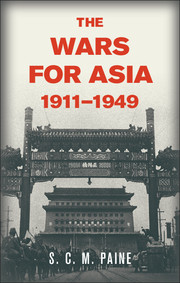Book contents
- Frontmatter
- Contents
- Maps
- Acknowledgments
- Technical Note
- Part I Fear and Ambition Japan, China, and Russia
- PART II Nested Wars
- 5 Flashback to 1911 and the Beginning of the Long Chinese Civil War
- 6 Regional War
- 7 Global War
- 8 The Final Act of the Long Chinese Civil War
- 9 Conclusion
- Chronology
- Notes
- Bibliography
- Index
5 - Flashback to 1911 and the Beginning of the Long Chinese Civil War
Published online by Cambridge University Press: 05 September 2012
- Frontmatter
- Contents
- Maps
- Acknowledgments
- Technical Note
- Part I Fear and Ambition Japan, China, and Russia
- PART II Nested Wars
- 5 Flashback to 1911 and the Beginning of the Long Chinese Civil War
- 6 Regional War
- 7 Global War
- 8 The Final Act of the Long Chinese Civil War
- 9 Conclusion
- Chronology
- Notes
- Bibliography
- Index
Summary
話說 It is said that
天下大勢 the world
分久必合 long divided must unite,
合久必分 and long united must divide.
Luo Guanzhong (c. 1330–1400), Romance of the Three KingdomsUnderstanding the magnitude of Chiang Kai-shek’s accomplishment with the Northern Expedition’s reunification of China and the magnitude of the task still lying ahead at the time of the Xi’an Incident requires a retrospective on China’s long civil war of the twentieth century that lasted from 1911 to 1949. This was a dreaded interregnum period between the Qing dynasty and its successor system of government. In Chinese history, periods of dynastic change, when central authority collapses and war ravages the land until the restoration of authority, typically last decades and are characterized by chaos, or 亂 (luan) in Chinese. The word resonates with evil foreboding.
In 1936, the chaos had been escalating for a century. Like the Japanese euphemism of “incidents” for wars, the Chinese apply the misnomer of “rebellions” to their civil wars. In the nineteenth century, China faced numerous and overlapping civil wars – the Taiping, Nian, and Donggan Rebellions – to name just the largest. These three alone may have taken up to 50 million lives. To put the figure in perspective, more than 57 million people died in World War II. These rebellions devastated virtually every province of China. The peak period lasted more than twenty years in the third quarter of the nineteenth century. China also simultaneously fought and lost a succession of regional wars against the colonial powers: the Opium Wars (1839–42, 1856–60), the Sino-French War (1883–5), the First Sino-Japanese War (1894–5), and the Boxer Uprising (1899–1901). The Boxer “Uprising,” another misnomer, was a civil war overlaid by a multinational invasion by all the great powers plus some.
- Type
- Chapter
- Information
- The Wars for Asia, 1911–1949 , pp. 109 - 121Publisher: Cambridge University PressPrint publication year: 2012



